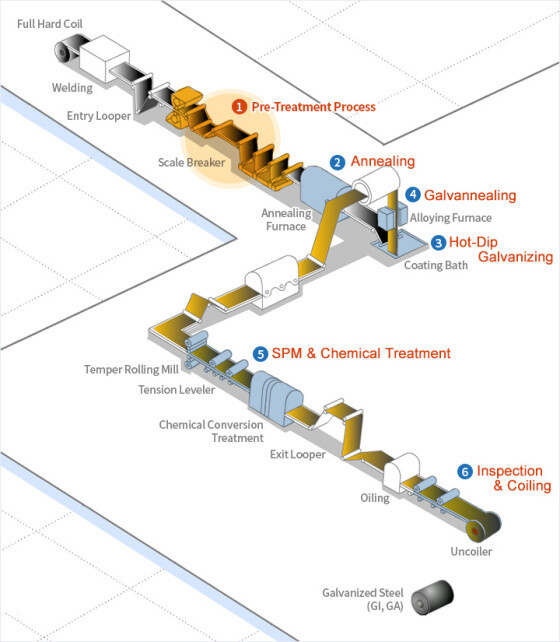 Cold Rolled Steel
Cold Rolled Steel1. Pickling: Hot rolled coils pass through a pickling line, where scale breaker machines and hydrochloric acid solutions are used to remove any surface scale and/or oxide film that which causes surface flaws during the final stage of cold rolled steel processing.
2. Cold Rolling: Pickled coils are cold rolled in tandem mills to a specified thickness, typically 40 to 90%, of original material dimensions. Fully automated shape adjustment is ensured through state of the art process machinery.
3. Electrolytic Cleaning: The purpose of electrolytic cleaning is to remove lubricant oil and contaminants on the cold rolled steel prior to the annealing process.
4. Annealing: This is a highly productive manufacturing method whereby steel products with extra deep drawing qualities and high tensile strength can be produced. Two annealing methods are commonly used: batch annealing and continuous annealing.
5. Skin Pass: This final rolling process is performed in order to remove minor surface defects such as stretch marks and to produce a smooth, lustrous surface. Skin Pass results in a further thickness reduction of about 1%.More Content Galvanized Steel
Galvanized Steel1. Pre-Treatment Process: Some rolling oil and other contaminants remain on the surface of cold rolled steel sheets following processing. These are removed by passing the electrically charged sheet through an alkaline solution which induces an electrochemical reaction.
2. Annealing: The material properties of the pre-treated steel sheet can be altered and improved through recrystallization during the annealing process.
3. Hot-Dip Galvanizing: After passing through the annealing furnace, steel sheets are dipped into a zinc pot where molten Zn is coated onto the surface. The desired coating weight is achieved by removing excess zinc before solidification with high-pressure air from an air knife.
4. Galvannealing: The surface of a steel sheet, after the air knife, can be coated with a zinc compound prior to reheating in an annealing process. Zn atoms diffuse into the Fe to create a Zn-Fe series alloy.
5. SPM & Chemical Treatment: In order to achieve a flat surface and an elegant finish, the steel sheet is processed with a skin pass mill. In order to prevent the white rust, which often forms on the surface of activated zinc, and to improve corrosion resistance, the surface is coated with a Cr-free resin.
6. lnspection & Coiling: In order to achieve a flat surface and an elegant finish, the steel sheet is processed with a skin pass mill. In order to prevent the white rust, which often forms on the surface of activated zinc, and to improve corrosion resistance, the surface is coated with a Cr-free resin.More Content

Related Posts
Online Message
Please give us a message


